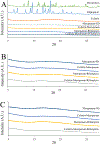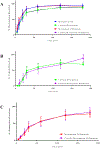Effects of the antibiotic component on in-vitro bacterial killing, physico-chemical properties, aerosolization and dissolution of a ternary-combinational inhalation powder formulation of antibiotics for pan-drug resistant Gram-negative lung infections
- PMID: 30797863
- PMCID: PMC6441383
- DOI: 10.1016/j.ijpharm.2019.02.018
Effects of the antibiotic component on in-vitro bacterial killing, physico-chemical properties, aerosolization and dissolution of a ternary-combinational inhalation powder formulation of antibiotics for pan-drug resistant Gram-negative lung infections
Abstract
Combinational antibiotic formulations have emerged as an important strategy to combat antibiotic resistance. The main objective of this study was to examine effects of individual components on the antimicrobial activity, physico-chemical properties, aerosolization and dissolution of powder aerosol formulations when three synergistic drugs were co-spray dried. A ternary dry powder formulation consisting of meropenem (75.5 %w/w), colistin (15.1 %w/w) and rifampicin (9.4 %w/w) at the selected ratio was produced by spray drying. The ternary formulation was characterized for in-vitro antibacterial activity, physico-chemical properties, surface composition, aerosol performance and dissolution. All of the formulations demonstrated excellent aerosolization behavior achieving a fine particle fraction of >70%, which was substantially higher than those for the Meropenem-SD and Colistin-Meropenem formulations. The results indicated that rifampicin controlled the surface morphology of the ternary and binary combination formulations resulting in the formation of highly corrugated particles. Advanced characterization of surface composition by XPS supported the hypothesis that rifampicin was enriched on the surface of the combination powder formulations. All spray-dried formulations were amorphous and absorbed substantial amount of water at the elevated humidity. Storage at the elevated humidity caused a substantial decline in aerosolization performance for the Meropenem-SD and Colistin-Meropenem, which was attributed to increased inter-particulate capillary forces or particle fusion. In contrast, the ternary combination and binary Meropenem-Rifampicin formulations showed no change in aerosol performance at the elevated storage humidity conditions; attributable to the enriched hydrophobicity of rifampicin on the particle surface that acted as a barrier against moisture condensation and particle fusion. Interestingly, in the ternary formulation rifampicin enrichment on the surface did not interfere with the dissolution of other two components (i.e. meropenem and colistin). Our study provides an insight on the impact of each component on the performance of co-spray dried combinational formulations.
Keywords: Aerosol performance; Dissolution; Dry powder inhaler; Solubility; Spray drying; Ternary combination.
Copyright © 2019 Elsevier B.V. All rights reserved.
Figures










Similar articles
-
Understanding the Impacts of Surface Compositions on the In-Vitro Dissolution and Aerosolization of Co-Spray-Dried Composite Powder Formulations for Inhalation.Pharm Res. 2018 Nov 7;36(1):6. doi: 10.1007/s11095-018-2527-x. Pharm Res. 2018. PMID: 30406281 Free PMC article.
-
Improved Physical Stability and Aerosolization of Inhalable Amorphous Ciprofloxacin Powder Formulations by Incorporating Synergistic Colistin.Mol Pharm. 2018 Sep 4;15(9):4004-4020. doi: 10.1021/acs.molpharmaceut.8b00445. Epub 2018 Aug 3. Mol Pharm. 2018. PMID: 30028947 Free PMC article.
-
Effects of Surface Composition on the Aerosolisation and Dissolution of Inhaled Antibiotic Combination Powders Consisting of Colistin and Rifampicin.AAPS J. 2016 Mar;18(2):372-84. doi: 10.1208/s12248-015-9848-z. Epub 2015 Nov 24. AAPS J. 2016. PMID: 26603890 Free PMC article.
-
Spray-Dried PulmoSphere™ Formulations for Inhalation Comprising Crystalline Drug Particles.AAPS PharmSciTech. 2019 Feb 7;20(3):103. doi: 10.1208/s12249-018-1280-0. AAPS PharmSciTech. 2019. PMID: 30734187 Review.
-
Physical stability of dry powder inhaler formulations.Expert Opin Drug Deliv. 2020 Jan;17(1):77-96. doi: 10.1080/17425247.2020.1702643. Epub 2019 Dec 13. Expert Opin Drug Deliv. 2020. PMID: 31815554 Free PMC article. Review.
Cited by
-
Co-Delivery of D-LAK Antimicrobial Peptide and Capreomycin as Inhaled Powder Formulation to Combat Drug-Resistant Tuberculosis.Pharm Res. 2023 May;40(5):1073-1086. doi: 10.1007/s11095-023-03488-y. Epub 2023 Mar 3. Pharm Res. 2023. PMID: 36869245 Free PMC article.
-
In vitro evaluation of drug delivery behavior for inhalable amorphous nanoparticle formulations in a human lung epithelial cell model.Int J Pharm. 2021 Mar 1;596:120211. doi: 10.1016/j.ijpharm.2021.120211. Epub 2021 Jan 21. Int J Pharm. 2021. PMID: 33486036 Free PMC article.
-
Excipient-Free Inhalable Microparticles of Azithromycin Produced by Electrospray: A Novel Approach to Direct Pulmonary Delivery of Antibiotics.Pharmaceutics. 2021 Nov 23;13(12):1988. doi: 10.3390/pharmaceutics13121988. Pharmaceutics. 2021. PMID: 34959270 Free PMC article.
-
Optimization of inhalable liposomal powder formulations and evaluation of their in vitro drug delivery behavior in Calu-3 human lung epithelial cells.Int J Pharm. 2020 Aug 30;586:119570. doi: 10.1016/j.ijpharm.2020.119570. Epub 2020 Jun 25. Int J Pharm. 2020. PMID: 32593649 Free PMC article.
-
Dry Powder Inhalers for Delivery of Synthetic Biomolecules.Pharmaceuticals (Basel). 2025 Jan 27;18(2):175. doi: 10.3390/ph18020175. Pharmaceuticals (Basel). 2025. PMID: 40005989 Free PMC article. Review.
References
-
- Ambrose PG, Bhavnani SM, Grosse EJE, Drusano GL, 2010. Pharmacokinetic-Pharmacodynamic Considerations in the Design of Hospital-Acquired or Ventilator-Associated Bacterial Pneumonia Studies: Look before You Leap! Clinical Infectious Diseases 51, S103–S110. - PubMed
-
- Bohr A, P Boetker J, Rades T, Rantanen J, Yang M, 2014. Application of spray-drying and electrospraying/electospinning for poorly watersoluble drugs: A particle engineering approach. Current pharmaceutical design 20, 325–348. - PubMed
-
- Boucher HW, Talbot GH, Bradley JS, Edwards JE, Gilbert D, Rice LB, Scheld M, Spellberg B, Bartlett J, 2009. Bad Bugs, No Drugs: No ESKAPE! An Update from the Infectious Diseases Society of America. Clinical Infectious Diseases 48, 1–12. - PubMed
MeSH terms
Substances
Grants and funding
LinkOut - more resources
Full Text Sources

